Managing Business Research: Motivation Theory at Starbucks, April 2020
VerifiedAdded on 2023/01/11
|13
|3570
|90
Report
AI Summary
This report, prepared for a Managing Business Research module, analyzes the impact of motivation theories on employee performance, specifically focusing on Starbucks. It begins by explaining key concepts such as Herzberg's two-factor theory and Alderfer's ERG theory, detailing how they can be applied to enhance employee motivation. The report then provides an overview of the contemporary context of the coffee shop industry and Starbucks, highlighting the importance of employee motivation for sustained success. It outlines a research plan, including objectives, research approaches (quantitative), and methods (questionnaires) for primary data collection, emphasizing the importance of ethical considerations. The report concludes by summarizing the key findings and implications of the study, offering valuable insights into improving employee performance through effective motivational strategies within a business context.
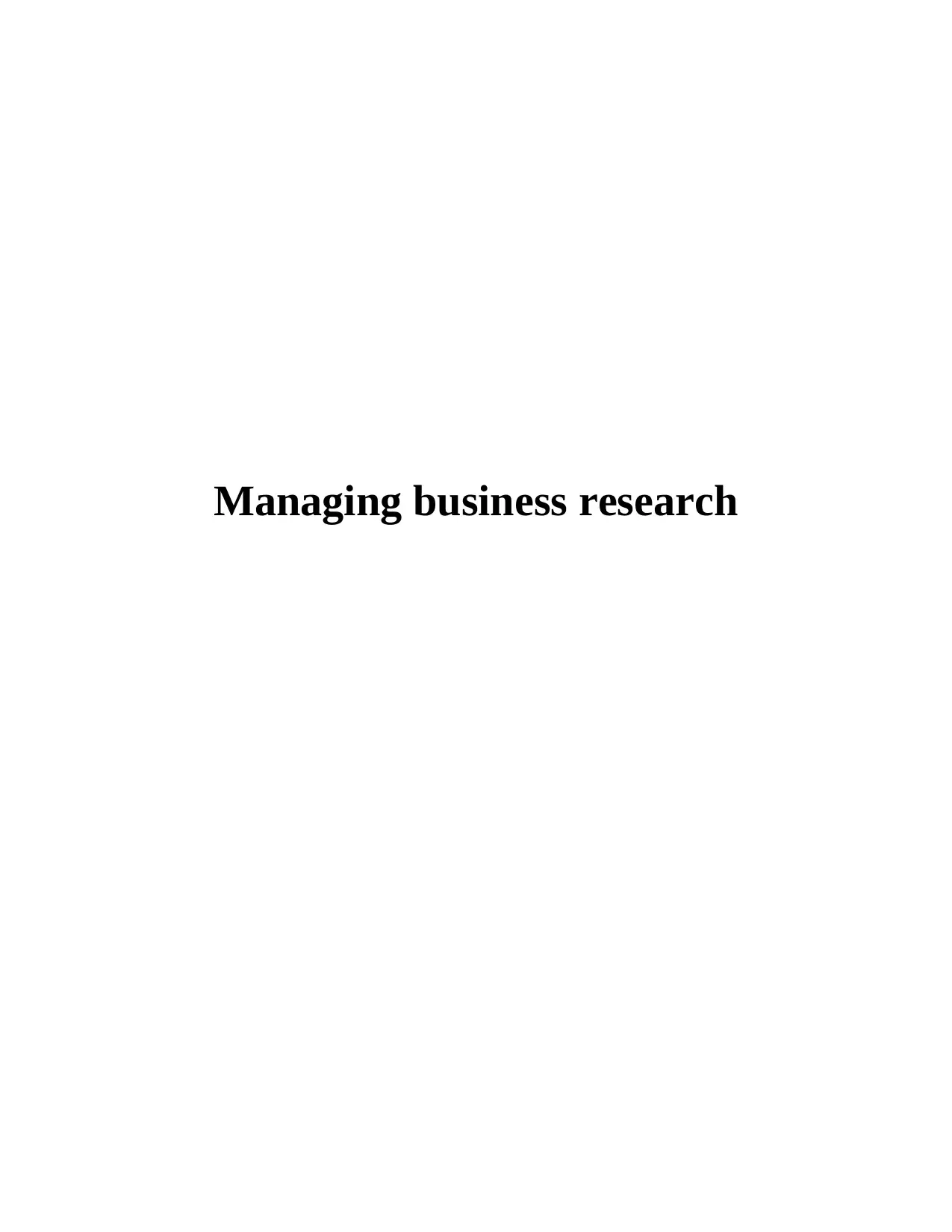
Managing business research
Paraphrase This Document
Need a fresh take? Get an instant paraphrase of this document with our AI Paraphraser
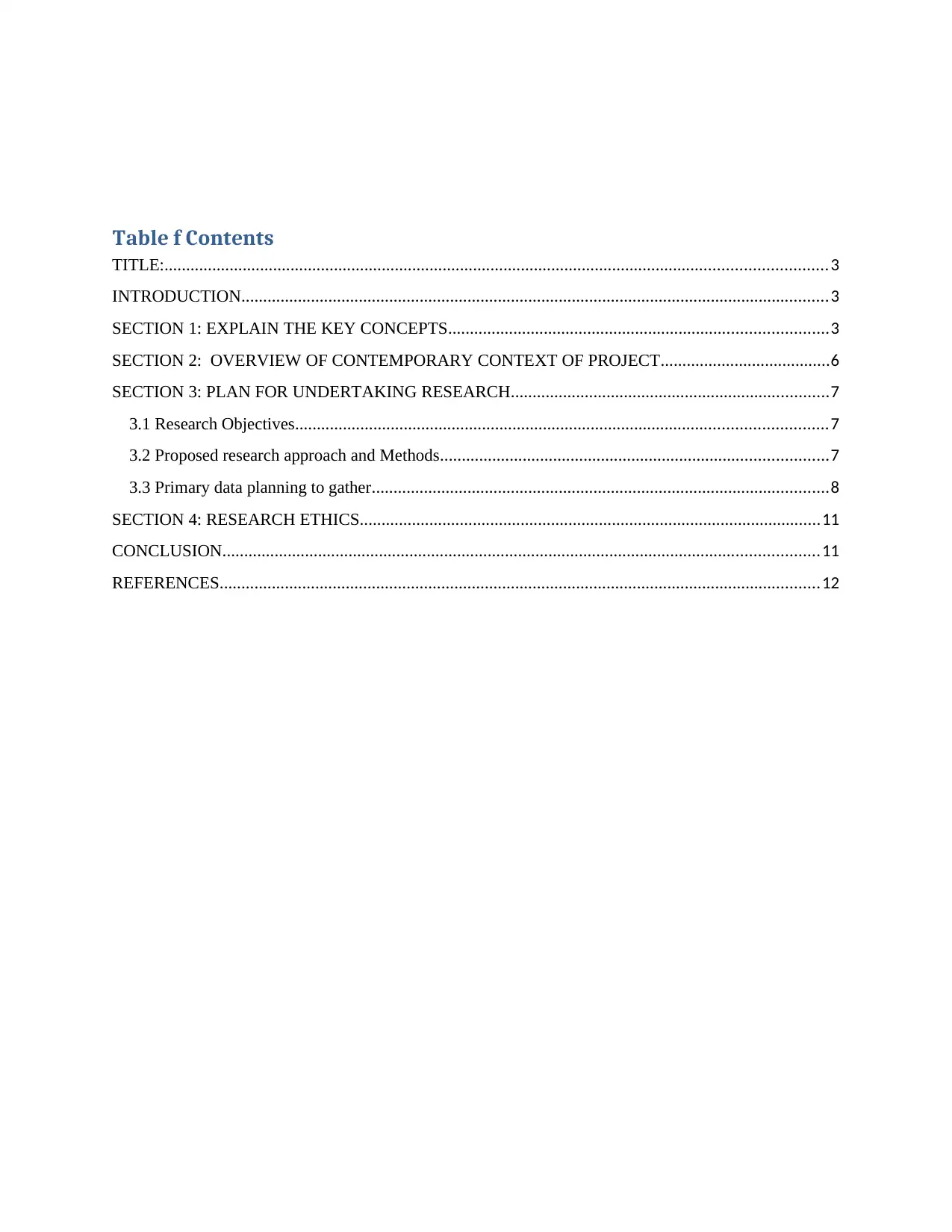
Table f Contents
TITLE:........................................................................................................................................................3
INTRODUCTION.......................................................................................................................................3
SECTION 1: EXPLAIN THE KEY CONCEPTS.......................................................................................3
SECTION 2: OVERVIEW OF CONTEMPORARY CONTEXT OF PROJECT.......................................6
SECTION 3: PLAN FOR UNDERTAKING RESEARCH.........................................................................7
3.1 Research Objectives..........................................................................................................................7
3.2 Proposed research approach and Methods.........................................................................................7
3.3 Primary data planning to gather.........................................................................................................8
SECTION 4: RESEARCH ETHICS..........................................................................................................11
CONCLUSION.........................................................................................................................................11
REFERENCES..........................................................................................................................................12
TITLE:........................................................................................................................................................3
INTRODUCTION.......................................................................................................................................3
SECTION 1: EXPLAIN THE KEY CONCEPTS.......................................................................................3
SECTION 2: OVERVIEW OF CONTEMPORARY CONTEXT OF PROJECT.......................................6
SECTION 3: PLAN FOR UNDERTAKING RESEARCH.........................................................................7
3.1 Research Objectives..........................................................................................................................7
3.2 Proposed research approach and Methods.........................................................................................7
3.3 Primary data planning to gather.........................................................................................................8
SECTION 4: RESEARCH ETHICS..........................................................................................................11
CONCLUSION.........................................................................................................................................11
REFERENCES..........................................................................................................................................12

TITLE: To analyze impact of motivation theory in improving employee performance. A study
on Starbucks.
INTRODUCTION
Motivation is process to stimulate an individual working in firm to focus towards
attaining specific objectives (Barton, Schaefer and Canavati, 2018). The employee motivation is
psychological forces which identify direction of behavior of an individual, effort level of person
of persistence. Motivation develops the positive impact on employee performance as the
motivated employees are more focus towards doing the organizational activities and attaining the
set objectives. The motivational theories are helpful in motivating the staff members at
workplace.
SECTION 1: EXPLAIN THE KEY CONCEPTS
Different motivational theories Starbucks can be used to improve employee performance
According to opinion of Beata Souders (2020) Motivational theory is mainly tasked with
searching what drive the people to work for attaining set objectives. The Starbucks organization
mainly used the motivational theories to motivate the staff members and also leading to
economic resources use. There are different motivational theories used by Starbucks given
below:
Herzberg's motivation-hygiene theory- This theory is proposed through Frederick Herzberg
and it is regarded as the two factor theory. Various job factors may fulfill individual
requirements and prevent dissatisfaction from other factors. This theory explores different
variables which are seen as beneficial to achieve aims and objectives and are often useful in
preventing undesirable circumstances. There are different factors used in Herzberg's motivation-
hygiene theory given below:
Hygiene factors- Herzberg determined the hygiene factors which are not intrinsic to a job
but contribute to the working conditions. This theory is important for the identification and
maintenance of hygiene factors that are not intrinsic in them, but often related to the
requirements for successful work. This is a Starbucks policy that is applicable to management,
on Starbucks.
INTRODUCTION
Motivation is process to stimulate an individual working in firm to focus towards
attaining specific objectives (Barton, Schaefer and Canavati, 2018). The employee motivation is
psychological forces which identify direction of behavior of an individual, effort level of person
of persistence. Motivation develops the positive impact on employee performance as the
motivated employees are more focus towards doing the organizational activities and attaining the
set objectives. The motivational theories are helpful in motivating the staff members at
workplace.
SECTION 1: EXPLAIN THE KEY CONCEPTS
Different motivational theories Starbucks can be used to improve employee performance
According to opinion of Beata Souders (2020) Motivational theory is mainly tasked with
searching what drive the people to work for attaining set objectives. The Starbucks organization
mainly used the motivational theories to motivate the staff members and also leading to
economic resources use. There are different motivational theories used by Starbucks given
below:
Herzberg's motivation-hygiene theory- This theory is proposed through Frederick Herzberg
and it is regarded as the two factor theory. Various job factors may fulfill individual
requirements and prevent dissatisfaction from other factors. This theory explores different
variables which are seen as beneficial to achieve aims and objectives and are often useful in
preventing undesirable circumstances. There are different factors used in Herzberg's motivation-
hygiene theory given below:
Hygiene factors- Herzberg determined the hygiene factors which are not intrinsic to a job
but contribute to the working conditions. This theory is important for the identification and
maintenance of hygiene factors that are not intrinsic in them, but often related to the
requirements for successful work. This is a Starbucks policy that is applicable to management,
⊘ This is a preview!⊘
Do you want full access?
Subscribe today to unlock all pages.

Trusted by 1+ million students worldwide
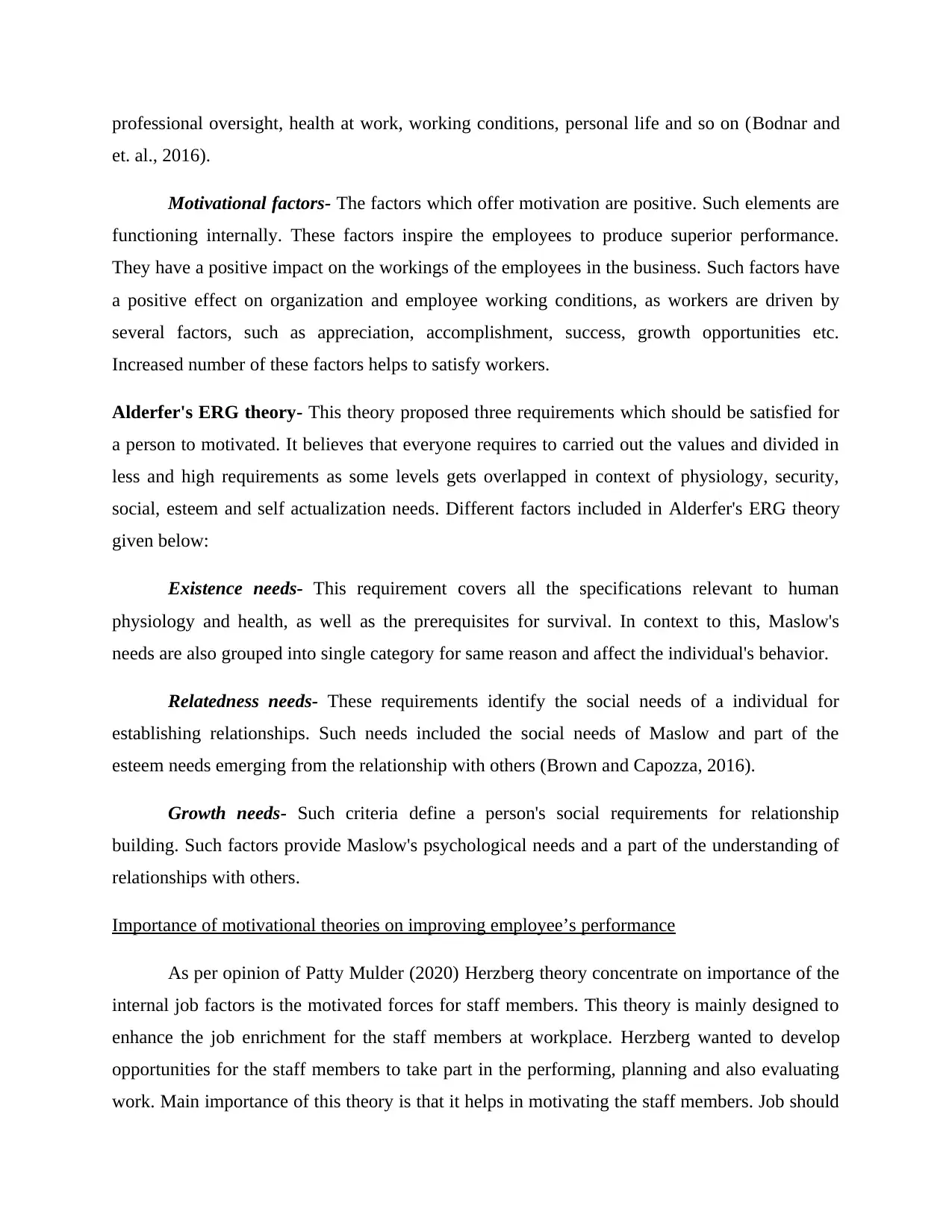
professional oversight, health at work, working conditions, personal life and so on (Bodnar and
et. al., 2016).
Motivational factors- The factors which offer motivation are positive. Such elements are
functioning internally. These factors inspire the employees to produce superior performance.
They have a positive impact on the workings of the employees in the business. Such factors have
a positive effect on organization and employee working conditions, as workers are driven by
several factors, such as appreciation, accomplishment, success, growth opportunities etc.
Increased number of these factors helps to satisfy workers.
Alderfer's ERG theory- This theory proposed three requirements which should be satisfied for
a person to motivated. It believes that everyone requires to carried out the values and divided in
less and high requirements as some levels gets overlapped in context of physiology, security,
social, esteem and self actualization needs. Different factors included in Alderfer's ERG theory
given below:
Existence needs- This requirement covers all the specifications relevant to human
physiology and health, as well as the prerequisites for survival. In context to this, Maslow's
needs are also grouped into single category for same reason and affect the individual's behavior.
Relatedness needs- These requirements identify the social needs of a individual for
establishing relationships. Such needs included the social needs of Maslow and part of the
esteem needs emerging from the relationship with others (Brown and Capozza, 2016).
Growth needs- Such criteria define a person's social requirements for relationship
building. Such factors provide Maslow's psychological needs and a part of the understanding of
relationships with others.
Importance of motivational theories on improving employee’s performance
As per opinion of Patty Mulder (2020) Herzberg theory concentrate on importance of the
internal job factors is the motivated forces for staff members. This theory is mainly designed to
enhance the job enrichment for the staff members at workplace. Herzberg wanted to develop
opportunities for the staff members to take part in the performing, planning and also evaluating
work. Main importance of this theory is that it helps in motivating the staff members. Job should
et. al., 2016).
Motivational factors- The factors which offer motivation are positive. Such elements are
functioning internally. These factors inspire the employees to produce superior performance.
They have a positive impact on the workings of the employees in the business. Such factors have
a positive effect on organization and employee working conditions, as workers are driven by
several factors, such as appreciation, accomplishment, success, growth opportunities etc.
Increased number of these factors helps to satisfy workers.
Alderfer's ERG theory- This theory proposed three requirements which should be satisfied for
a person to motivated. It believes that everyone requires to carried out the values and divided in
less and high requirements as some levels gets overlapped in context of physiology, security,
social, esteem and self actualization needs. Different factors included in Alderfer's ERG theory
given below:
Existence needs- This requirement covers all the specifications relevant to human
physiology and health, as well as the prerequisites for survival. In context to this, Maslow's
needs are also grouped into single category for same reason and affect the individual's behavior.
Relatedness needs- These requirements identify the social needs of a individual for
establishing relationships. Such needs included the social needs of Maslow and part of the
esteem needs emerging from the relationship with others (Brown and Capozza, 2016).
Growth needs- Such criteria define a person's social requirements for relationship
building. Such factors provide Maslow's psychological needs and a part of the understanding of
relationships with others.
Importance of motivational theories on improving employee’s performance
As per opinion of Patty Mulder (2020) Herzberg theory concentrate on importance of the
internal job factors is the motivated forces for staff members. This theory is mainly designed to
enhance the job enrichment for the staff members at workplace. Herzberg wanted to develop
opportunities for the staff members to take part in the performing, planning and also evaluating
work. Main importance of this theory is that it helps in motivating the staff members. Job should
Paraphrase This Document
Need a fresh take? Get an instant paraphrase of this document with our AI Paraphraser
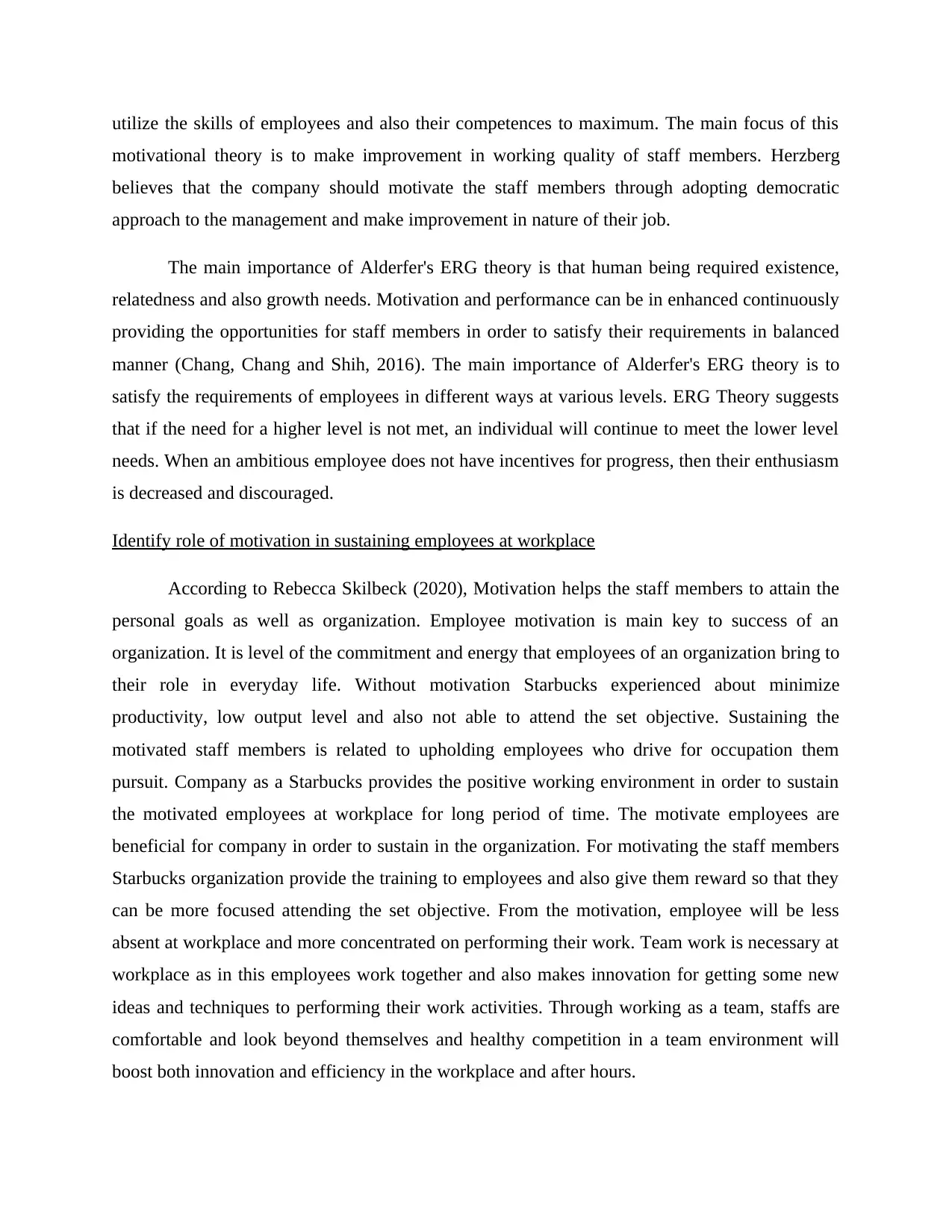
utilize the skills of employees and also their competences to maximum. The main focus of this
motivational theory is to make improvement in working quality of staff members. Herzberg
believes that the company should motivate the staff members through adopting democratic
approach to the management and make improvement in nature of their job.
The main importance of Alderfer's ERG theory is that human being required existence,
relatedness and also growth needs. Motivation and performance can be in enhanced continuously
providing the opportunities for staff members in order to satisfy their requirements in balanced
manner (Chang, Chang and Shih, 2016). The main importance of Alderfer's ERG theory is to
satisfy the requirements of employees in different ways at various levels. ERG Theory suggests
that if the need for a higher level is not met, an individual will continue to meet the lower level
needs. When an ambitious employee does not have incentives for progress, then their enthusiasm
is decreased and discouraged.
Identify role of motivation in sustaining employees at workplace
According to Rebecca Skilbeck (2020), Motivation helps the staff members to attain the
personal goals as well as organization. Employee motivation is main key to success of an
organization. It is level of the commitment and energy that employees of an organization bring to
their role in everyday life. Without motivation Starbucks experienced about minimize
productivity, low output level and also not able to attend the set objective. Sustaining the
motivated staff members is related to upholding employees who drive for occupation them
pursuit. Company as a Starbucks provides the positive working environment in order to sustain
the motivated employees at workplace for long period of time. The motivate employees are
beneficial for company in order to sustain in the organization. For motivating the staff members
Starbucks organization provide the training to employees and also give them reward so that they
can be more focused attending the set objective. From the motivation, employee will be less
absent at workplace and more concentrated on performing their work. Team work is necessary at
workplace as in this employees work together and also makes innovation for getting some new
ideas and techniques to performing their work activities. Through working as a team, staffs are
comfortable and look beyond themselves and healthy competition in a team environment will
boost both innovation and efficiency in the workplace and after hours.
motivational theory is to make improvement in working quality of staff members. Herzberg
believes that the company should motivate the staff members through adopting democratic
approach to the management and make improvement in nature of their job.
The main importance of Alderfer's ERG theory is that human being required existence,
relatedness and also growth needs. Motivation and performance can be in enhanced continuously
providing the opportunities for staff members in order to satisfy their requirements in balanced
manner (Chang, Chang and Shih, 2016). The main importance of Alderfer's ERG theory is to
satisfy the requirements of employees in different ways at various levels. ERG Theory suggests
that if the need for a higher level is not met, an individual will continue to meet the lower level
needs. When an ambitious employee does not have incentives for progress, then their enthusiasm
is decreased and discouraged.
Identify role of motivation in sustaining employees at workplace
According to Rebecca Skilbeck (2020), Motivation helps the staff members to attain the
personal goals as well as organization. Employee motivation is main key to success of an
organization. It is level of the commitment and energy that employees of an organization bring to
their role in everyday life. Without motivation Starbucks experienced about minimize
productivity, low output level and also not able to attend the set objective. Sustaining the
motivated staff members is related to upholding employees who drive for occupation them
pursuit. Company as a Starbucks provides the positive working environment in order to sustain
the motivated employees at workplace for long period of time. The motivate employees are
beneficial for company in order to sustain in the organization. For motivating the staff members
Starbucks organization provide the training to employees and also give them reward so that they
can be more focused attending the set objective. From the motivation, employee will be less
absent at workplace and more concentrated on performing their work. Team work is necessary at
workplace as in this employees work together and also makes innovation for getting some new
ideas and techniques to performing their work activities. Through working as a team, staffs are
comfortable and look beyond themselves and healthy competition in a team environment will
boost both innovation and efficiency in the workplace and after hours.
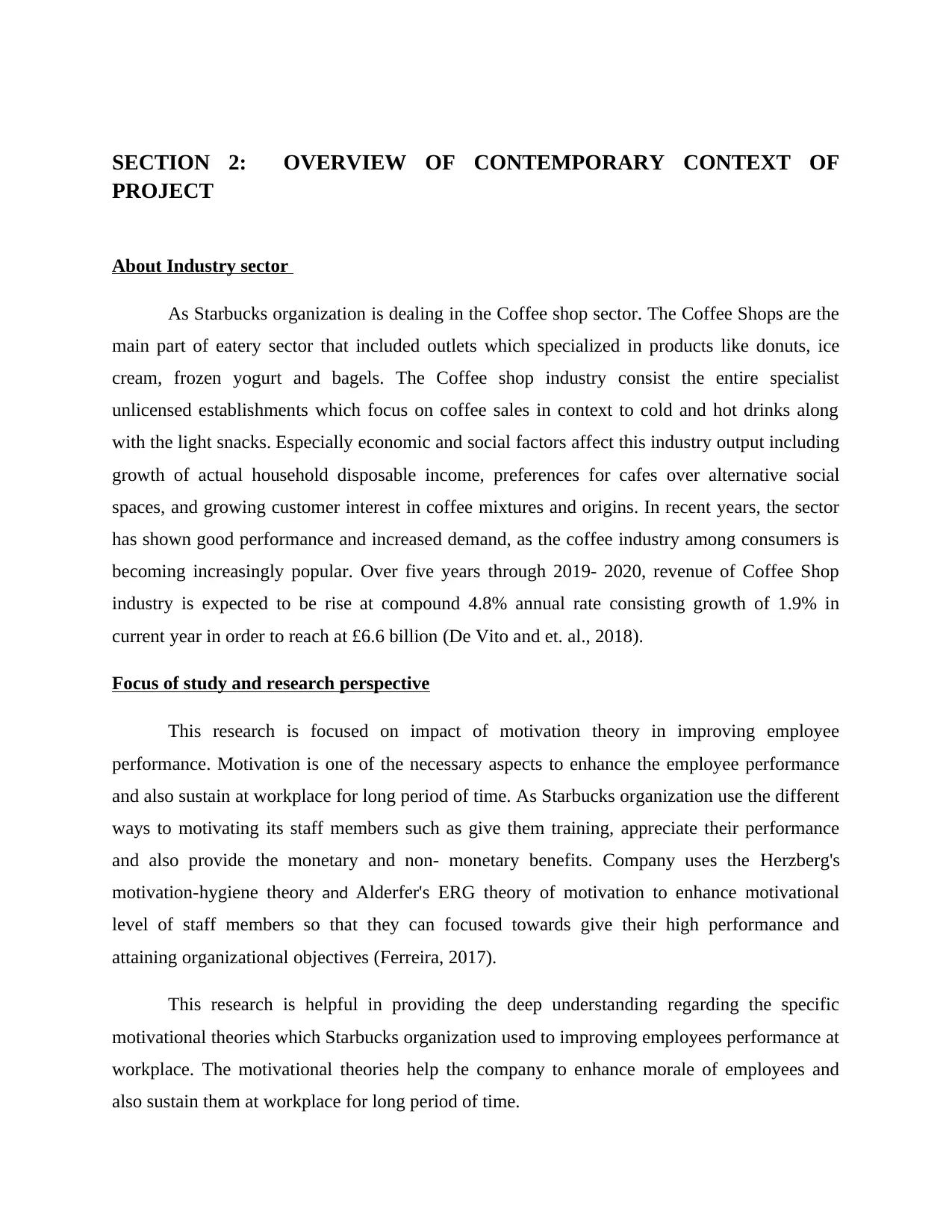
SECTION 2: OVERVIEW OF CONTEMPORARY CONTEXT OF
PROJECT
About Industry sector
As Starbucks organization is dealing in the Coffee shop sector. The Coffee Shops are the
main part of eatery sector that included outlets which specialized in products like donuts, ice
cream, frozen yogurt and bagels. The Coffee shop industry consist the entire specialist
unlicensed establishments which focus on coffee sales in context to cold and hot drinks along
with the light snacks. Especially economic and social factors affect this industry output including
growth of actual household disposable income, preferences for cafes over alternative social
spaces, and growing customer interest in coffee mixtures and origins. In recent years, the sector
has shown good performance and increased demand, as the coffee industry among consumers is
becoming increasingly popular. Over five years through 2019- 2020, revenue of Coffee Shop
industry is expected to be rise at compound 4.8% annual rate consisting growth of 1.9% in
current year in order to reach at £6.6 billion (De Vito and et. al., 2018).
Focus of study and research perspective
This research is focused on impact of motivation theory in improving employee
performance. Motivation is one of the necessary aspects to enhance the employee performance
and also sustain at workplace for long period of time. As Starbucks organization use the different
ways to motivating its staff members such as give them training, appreciate their performance
and also provide the monetary and non- monetary benefits. Company uses the Herzberg's
motivation-hygiene theory and Alderfer's ERG theory of motivation to enhance motivational
level of staff members so that they can focused towards give their high performance and
attaining organizational objectives (Ferreira, 2017).
This research is helpful in providing the deep understanding regarding the specific
motivational theories which Starbucks organization used to improving employees performance at
workplace. The motivational theories help the company to enhance morale of employees and
also sustain them at workplace for long period of time.
PROJECT
About Industry sector
As Starbucks organization is dealing in the Coffee shop sector. The Coffee Shops are the
main part of eatery sector that included outlets which specialized in products like donuts, ice
cream, frozen yogurt and bagels. The Coffee shop industry consist the entire specialist
unlicensed establishments which focus on coffee sales in context to cold and hot drinks along
with the light snacks. Especially economic and social factors affect this industry output including
growth of actual household disposable income, preferences for cafes over alternative social
spaces, and growing customer interest in coffee mixtures and origins. In recent years, the sector
has shown good performance and increased demand, as the coffee industry among consumers is
becoming increasingly popular. Over five years through 2019- 2020, revenue of Coffee Shop
industry is expected to be rise at compound 4.8% annual rate consisting growth of 1.9% in
current year in order to reach at £6.6 billion (De Vito and et. al., 2018).
Focus of study and research perspective
This research is focused on impact of motivation theory in improving employee
performance. Motivation is one of the necessary aspects to enhance the employee performance
and also sustain at workplace for long period of time. As Starbucks organization use the different
ways to motivating its staff members such as give them training, appreciate their performance
and also provide the monetary and non- monetary benefits. Company uses the Herzberg's
motivation-hygiene theory and Alderfer's ERG theory of motivation to enhance motivational
level of staff members so that they can focused towards give their high performance and
attaining organizational objectives (Ferreira, 2017).
This research is helpful in providing the deep understanding regarding the specific
motivational theories which Starbucks organization used to improving employees performance at
workplace. The motivational theories help the company to enhance morale of employees and
also sustain them at workplace for long period of time.
⊘ This is a preview!⊘
Do you want full access?
Subscribe today to unlock all pages.

Trusted by 1+ million students worldwide
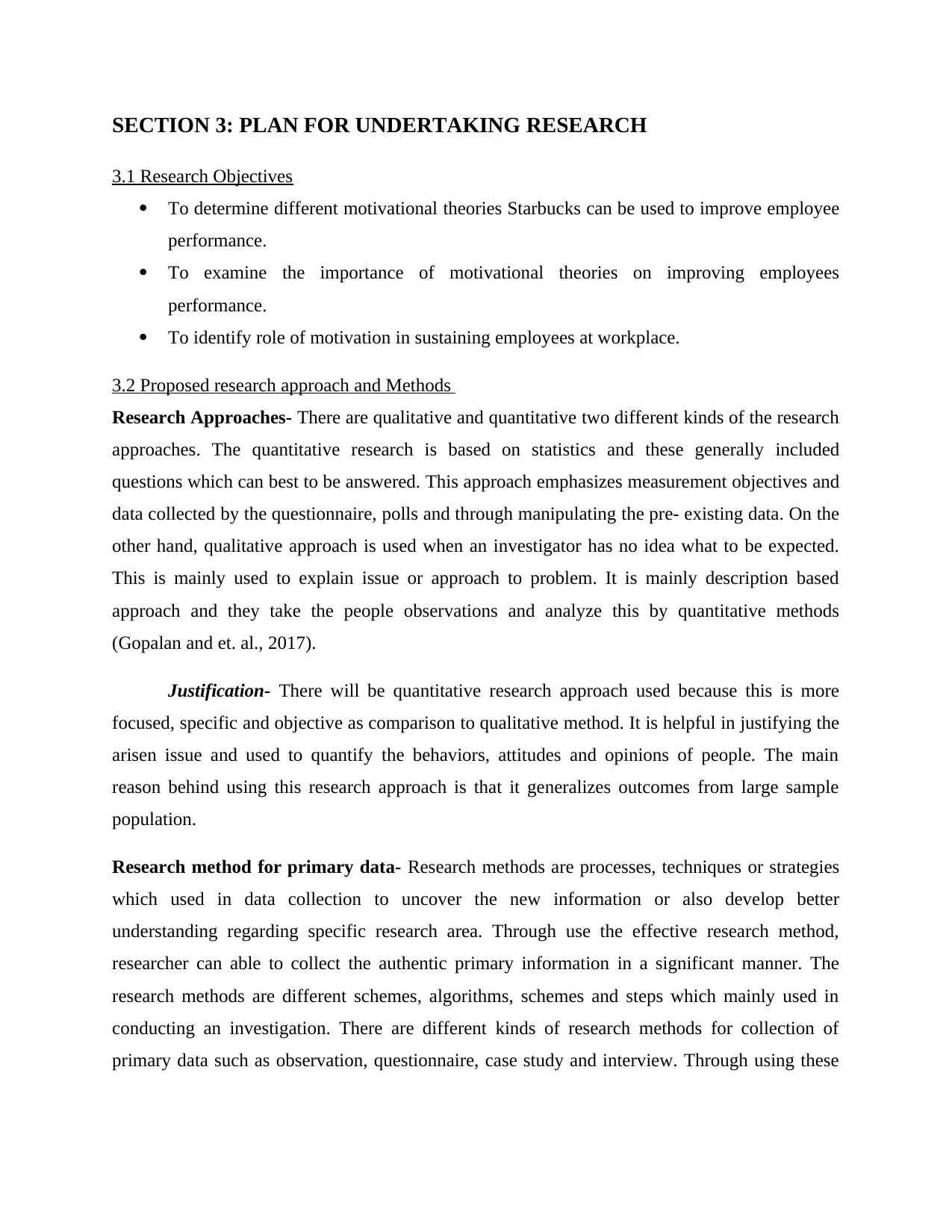
SECTION 3: PLAN FOR UNDERTAKING RESEARCH
3.1 Research Objectives
To determine different motivational theories Starbucks can be used to improve employee
performance.
To examine the importance of motivational theories on improving employees
performance.
To identify role of motivation in sustaining employees at workplace.
3.2 Proposed research approach and Methods
Research Approaches- There are qualitative and quantitative two different kinds of the research
approaches. The quantitative research is based on statistics and these generally included
questions which can best to be answered. This approach emphasizes measurement objectives and
data collected by the questionnaire, polls and through manipulating the pre- existing data. On the
other hand, qualitative approach is used when an investigator has no idea what to be expected.
This is mainly used to explain issue or approach to problem. It is mainly description based
approach and they take the people observations and analyze this by quantitative methods
(Gopalan and et. al., 2017).
Justification- There will be quantitative research approach used because this is more
focused, specific and objective as comparison to qualitative method. It is helpful in justifying the
arisen issue and used to quantify the behaviors, attitudes and opinions of people. The main
reason behind using this research approach is that it generalizes outcomes from large sample
population.
Research method for primary data- Research methods are processes, techniques or strategies
which used in data collection to uncover the new information or also develop better
understanding regarding specific research area. Through use the effective research method,
researcher can able to collect the authentic primary information in a significant manner. The
research methods are different schemes, algorithms, schemes and steps which mainly used in
conducting an investigation. There are different kinds of research methods for collection of
primary data such as observation, questionnaire, case study and interview. Through using these
3.1 Research Objectives
To determine different motivational theories Starbucks can be used to improve employee
performance.
To examine the importance of motivational theories on improving employees
performance.
To identify role of motivation in sustaining employees at workplace.
3.2 Proposed research approach and Methods
Research Approaches- There are qualitative and quantitative two different kinds of the research
approaches. The quantitative research is based on statistics and these generally included
questions which can best to be answered. This approach emphasizes measurement objectives and
data collected by the questionnaire, polls and through manipulating the pre- existing data. On the
other hand, qualitative approach is used when an investigator has no idea what to be expected.
This is mainly used to explain issue or approach to problem. It is mainly description based
approach and they take the people observations and analyze this by quantitative methods
(Gopalan and et. al., 2017).
Justification- There will be quantitative research approach used because this is more
focused, specific and objective as comparison to qualitative method. It is helpful in justifying the
arisen issue and used to quantify the behaviors, attitudes and opinions of people. The main
reason behind using this research approach is that it generalizes outcomes from large sample
population.
Research method for primary data- Research methods are processes, techniques or strategies
which used in data collection to uncover the new information or also develop better
understanding regarding specific research area. Through use the effective research method,
researcher can able to collect the authentic primary information in a significant manner. The
research methods are different schemes, algorithms, schemes and steps which mainly used in
conducting an investigation. There are different kinds of research methods for collection of
primary data such as observation, questionnaire, case study and interview. Through using these
Paraphrase This Document
Need a fresh take? Get an instant paraphrase of this document with our AI Paraphraser
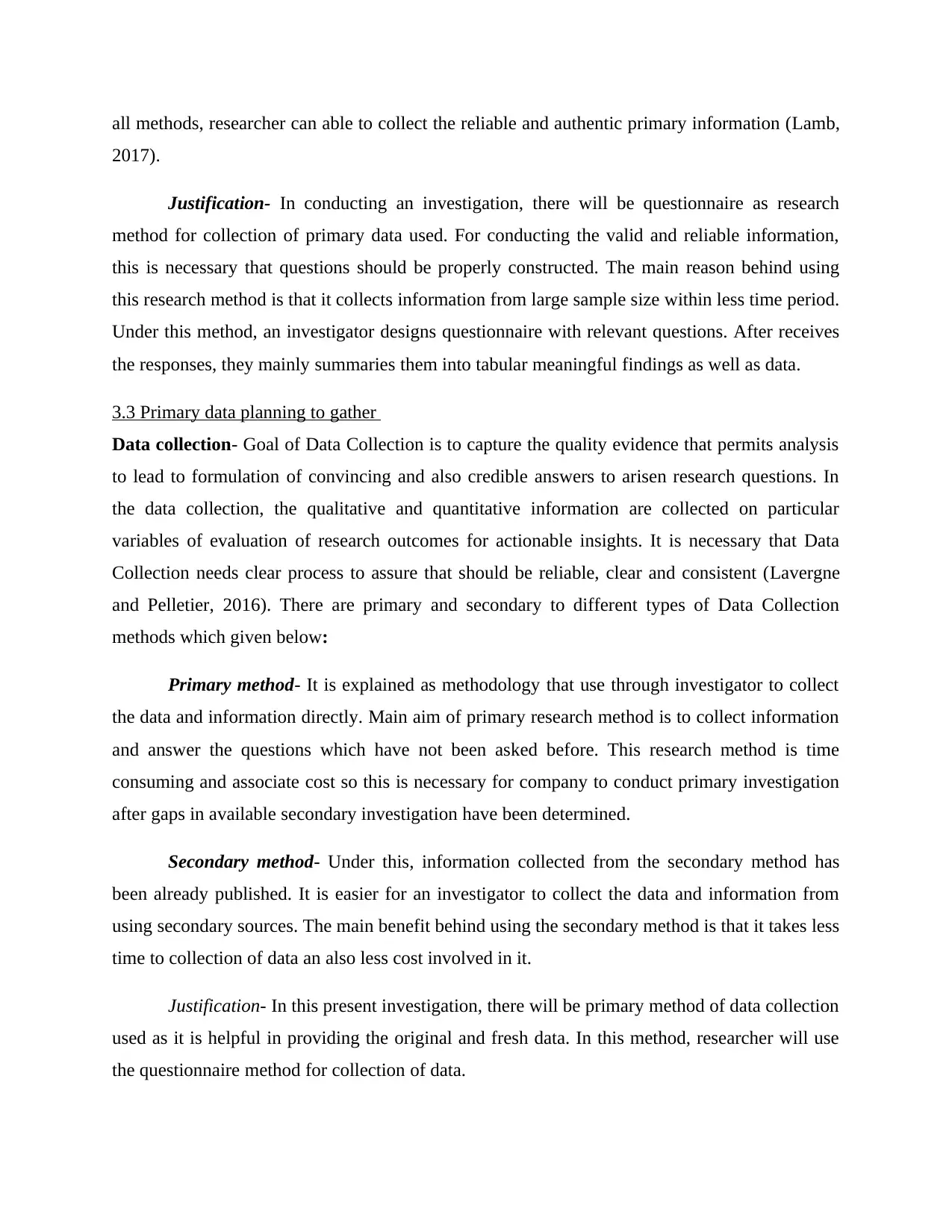
all methods, researcher can able to collect the reliable and authentic primary information (Lamb,
2017).
Justification- In conducting an investigation, there will be questionnaire as research
method for collection of primary data used. For conducting the valid and reliable information,
this is necessary that questions should be properly constructed. The main reason behind using
this research method is that it collects information from large sample size within less time period.
Under this method, an investigator designs questionnaire with relevant questions. After receives
the responses, they mainly summaries them into tabular meaningful findings as well as data.
3.3 Primary data planning to gather
Data collection- Goal of Data Collection is to capture the quality evidence that permits analysis
to lead to formulation of convincing and also credible answers to arisen research questions. In
the data collection, the qualitative and quantitative information are collected on particular
variables of evaluation of research outcomes for actionable insights. It is necessary that Data
Collection needs clear process to assure that should be reliable, clear and consistent (Lavergne
and Pelletier, 2016). There are primary and secondary to different types of Data Collection
methods which given below:
Primary method- It is explained as methodology that use through investigator to collect
the data and information directly. Main aim of primary research method is to collect information
and answer the questions which have not been asked before. This research method is time
consuming and associate cost so this is necessary for company to conduct primary investigation
after gaps in available secondary investigation have been determined.
Secondary method- Under this, information collected from the secondary method has
been already published. It is easier for an investigator to collect the data and information from
using secondary sources. The main benefit behind using the secondary method is that it takes less
time to collection of data an also less cost involved in it.
Justification- In this present investigation, there will be primary method of data collection
used as it is helpful in providing the original and fresh data. In this method, researcher will use
the questionnaire method for collection of data.
2017).
Justification- In conducting an investigation, there will be questionnaire as research
method for collection of primary data used. For conducting the valid and reliable information,
this is necessary that questions should be properly constructed. The main reason behind using
this research method is that it collects information from large sample size within less time period.
Under this method, an investigator designs questionnaire with relevant questions. After receives
the responses, they mainly summaries them into tabular meaningful findings as well as data.
3.3 Primary data planning to gather
Data collection- Goal of Data Collection is to capture the quality evidence that permits analysis
to lead to formulation of convincing and also credible answers to arisen research questions. In
the data collection, the qualitative and quantitative information are collected on particular
variables of evaluation of research outcomes for actionable insights. It is necessary that Data
Collection needs clear process to assure that should be reliable, clear and consistent (Lavergne
and Pelletier, 2016). There are primary and secondary to different types of Data Collection
methods which given below:
Primary method- It is explained as methodology that use through investigator to collect
the data and information directly. Main aim of primary research method is to collect information
and answer the questions which have not been asked before. This research method is time
consuming and associate cost so this is necessary for company to conduct primary investigation
after gaps in available secondary investigation have been determined.
Secondary method- Under this, information collected from the secondary method has
been already published. It is easier for an investigator to collect the data and information from
using secondary sources. The main benefit behind using the secondary method is that it takes less
time to collection of data an also less cost involved in it.
Justification- In this present investigation, there will be primary method of data collection
used as it is helpful in providing the original and fresh data. In this method, researcher will use
the questionnaire method for collection of data.
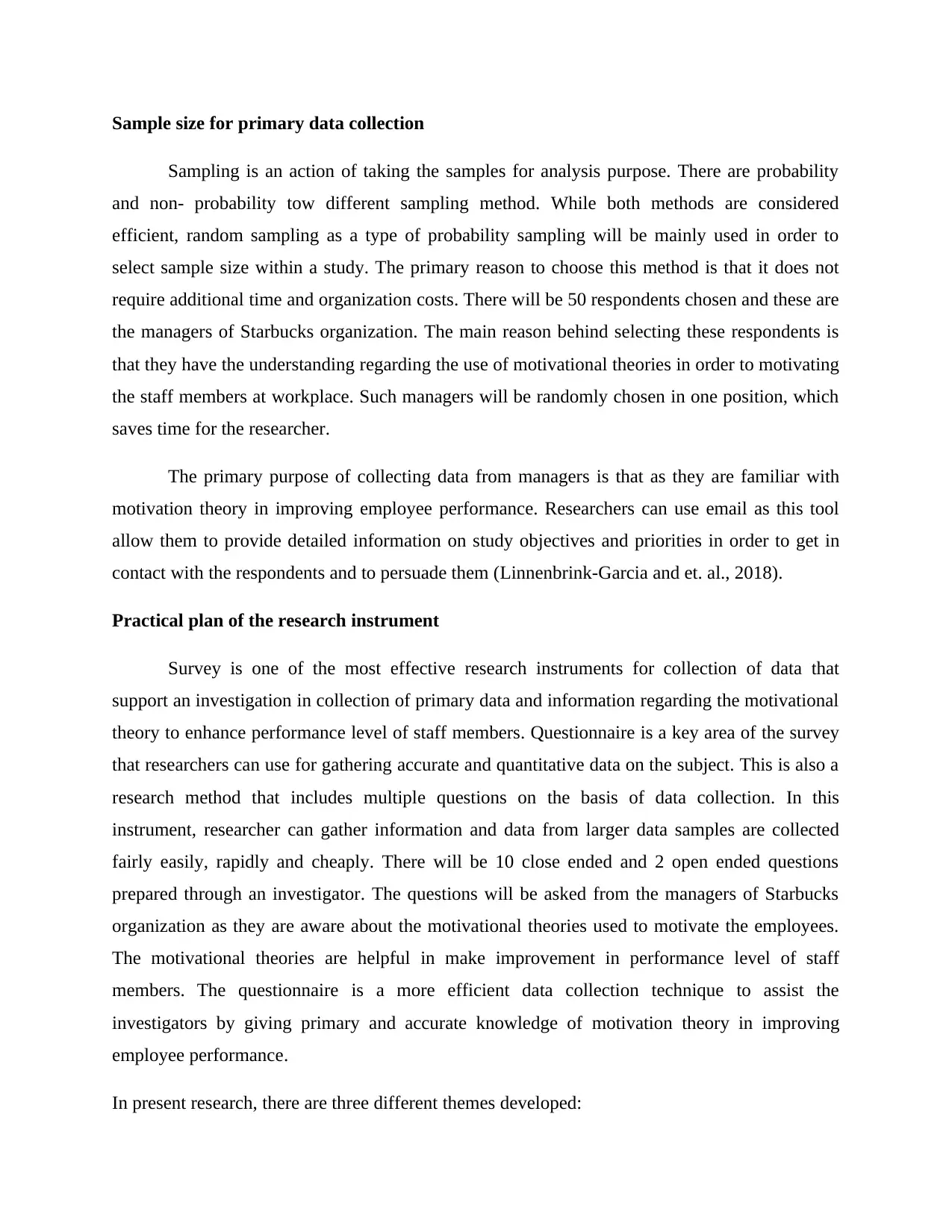
Sample size for primary data collection
Sampling is an action of taking the samples for analysis purpose. There are probability
and non- probability tow different sampling method. While both methods are considered
efficient, random sampling as a type of probability sampling will be mainly used in order to
select sample size within a study. The primary reason to choose this method is that it does not
require additional time and organization costs. There will be 50 respondents chosen and these are
the managers of Starbucks organization. The main reason behind selecting these respondents is
that they have the understanding regarding the use of motivational theories in order to motivating
the staff members at workplace. Such managers will be randomly chosen in one position, which
saves time for the researcher.
The primary purpose of collecting data from managers is that as they are familiar with
motivation theory in improving employee performance. Researchers can use email as this tool
allow them to provide detailed information on study objectives and priorities in order to get in
contact with the respondents and to persuade them (Linnenbrink-Garcia and et. al., 2018).
Practical plan of the research instrument
Survey is one of the most effective research instruments for collection of data that
support an investigation in collection of primary data and information regarding the motivational
theory to enhance performance level of staff members. Questionnaire is a key area of the survey
that researchers can use for gathering accurate and quantitative data on the subject. This is also a
research method that includes multiple questions on the basis of data collection. In this
instrument, researcher can gather information and data from larger data samples are collected
fairly easily, rapidly and cheaply. There will be 10 close ended and 2 open ended questions
prepared through an investigator. The questions will be asked from the managers of Starbucks
organization as they are aware about the motivational theories used to motivate the employees.
The motivational theories are helpful in make improvement in performance level of staff
members. The questionnaire is a more efficient data collection technique to assist the
investigators by giving primary and accurate knowledge of motivation theory in improving
employee performance.
In present research, there are three different themes developed:
Sampling is an action of taking the samples for analysis purpose. There are probability
and non- probability tow different sampling method. While both methods are considered
efficient, random sampling as a type of probability sampling will be mainly used in order to
select sample size within a study. The primary reason to choose this method is that it does not
require additional time and organization costs. There will be 50 respondents chosen and these are
the managers of Starbucks organization. The main reason behind selecting these respondents is
that they have the understanding regarding the use of motivational theories in order to motivating
the staff members at workplace. Such managers will be randomly chosen in one position, which
saves time for the researcher.
The primary purpose of collecting data from managers is that as they are familiar with
motivation theory in improving employee performance. Researchers can use email as this tool
allow them to provide detailed information on study objectives and priorities in order to get in
contact with the respondents and to persuade them (Linnenbrink-Garcia and et. al., 2018).
Practical plan of the research instrument
Survey is one of the most effective research instruments for collection of data that
support an investigation in collection of primary data and information regarding the motivational
theory to enhance performance level of staff members. Questionnaire is a key area of the survey
that researchers can use for gathering accurate and quantitative data on the subject. This is also a
research method that includes multiple questions on the basis of data collection. In this
instrument, researcher can gather information and data from larger data samples are collected
fairly easily, rapidly and cheaply. There will be 10 close ended and 2 open ended questions
prepared through an investigator. The questions will be asked from the managers of Starbucks
organization as they are aware about the motivational theories used to motivate the employees.
The motivational theories are helpful in make improvement in performance level of staff
members. The questionnaire is a more efficient data collection technique to assist the
investigators by giving primary and accurate knowledge of motivation theory in improving
employee performance.
In present research, there are three different themes developed:
⊘ This is a preview!⊘
Do you want full access?
Subscribe today to unlock all pages.

Trusted by 1+ million students worldwide
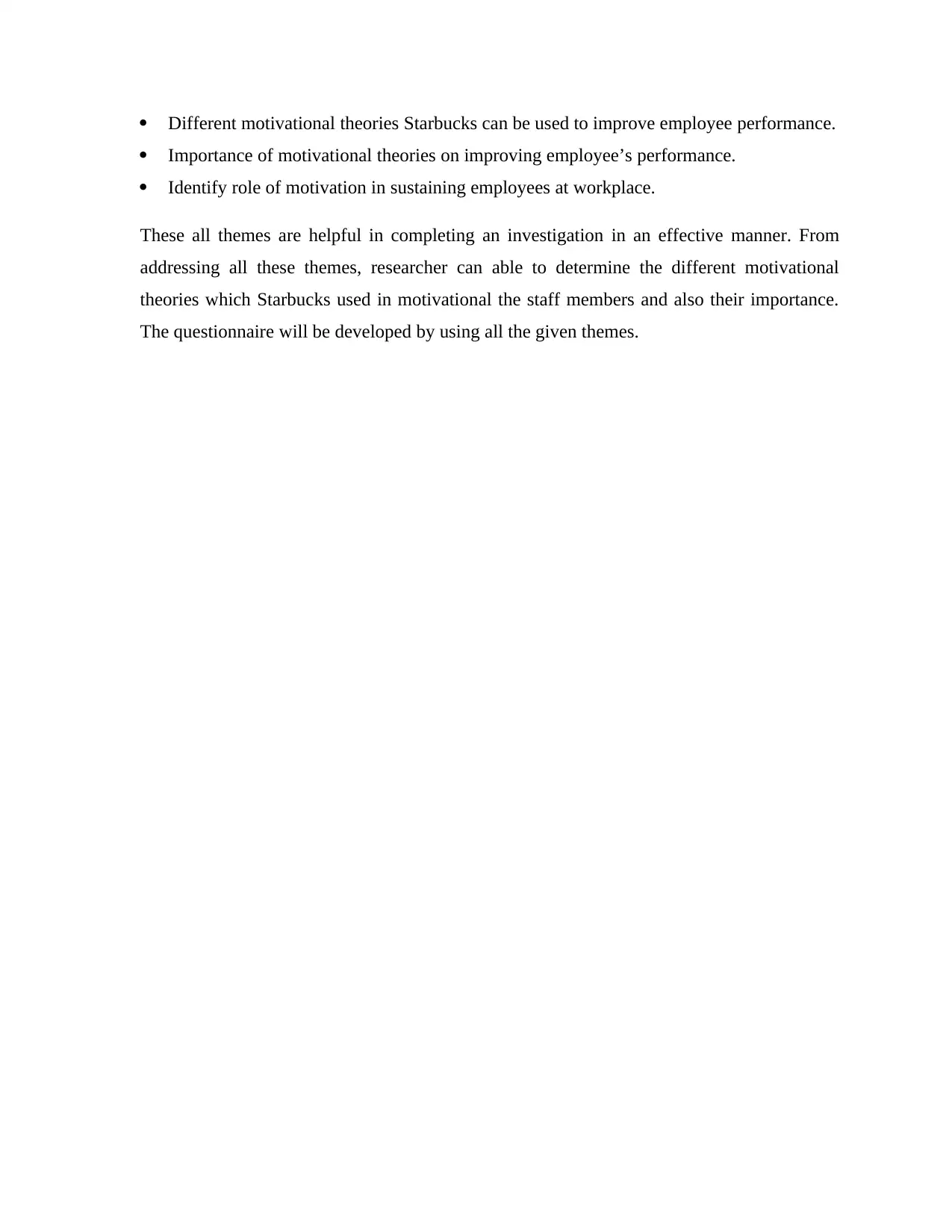
Different motivational theories Starbucks can be used to improve employee performance.
Importance of motivational theories on improving employee’s performance.
Identify role of motivation in sustaining employees at workplace.
These all themes are helpful in completing an investigation in an effective manner. From
addressing all these themes, researcher can able to determine the different motivational
theories which Starbucks used in motivational the staff members and also their importance.
The questionnaire will be developed by using all the given themes.
Importance of motivational theories on improving employee’s performance.
Identify role of motivation in sustaining employees at workplace.
These all themes are helpful in completing an investigation in an effective manner. From
addressing all these themes, researcher can able to determine the different motivational
theories which Starbucks used in motivational the staff members and also their importance.
The questionnaire will be developed by using all the given themes.
Paraphrase This Document
Need a fresh take? Get an instant paraphrase of this document with our AI Paraphraser
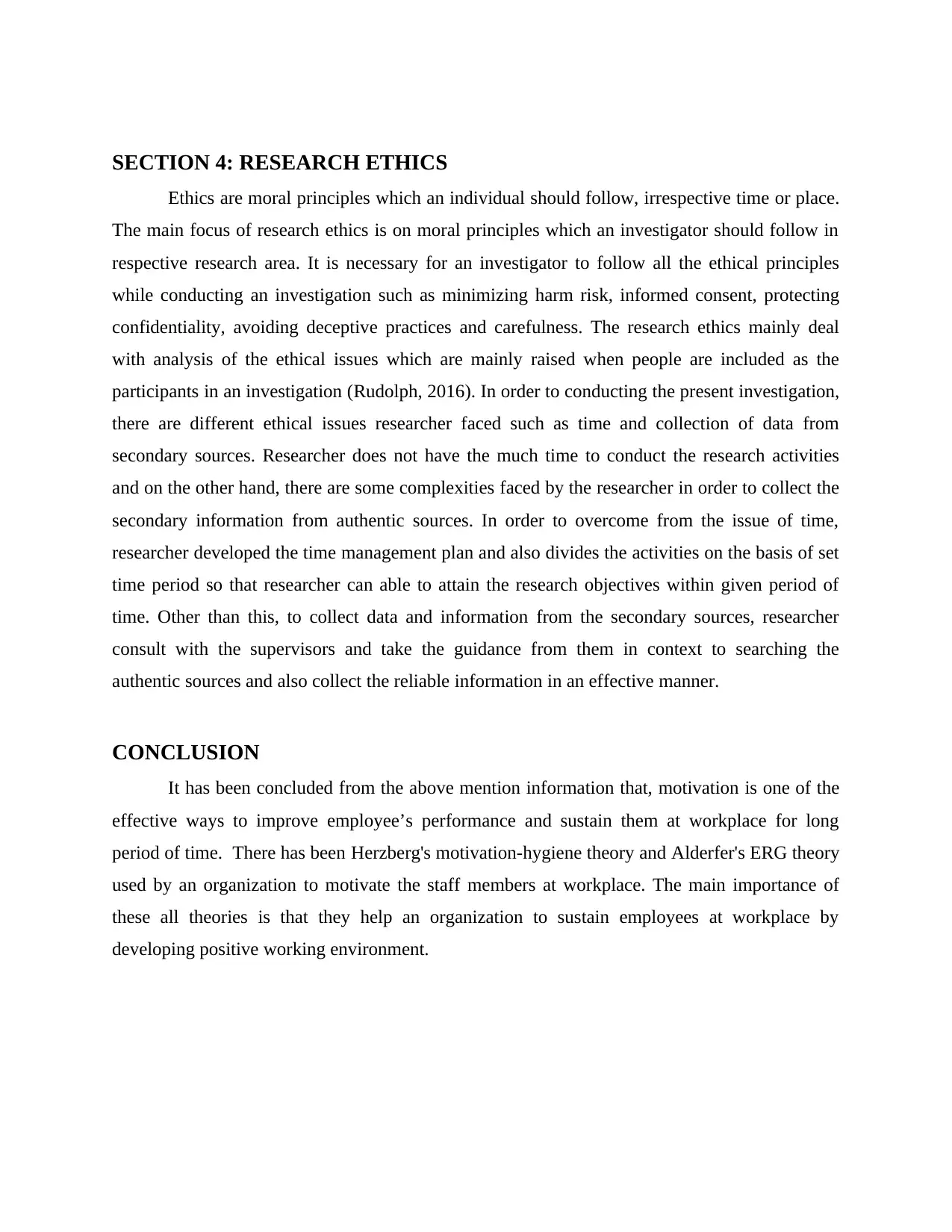
SECTION 4: RESEARCH ETHICS
Ethics are moral principles which an individual should follow, irrespective time or place.
The main focus of research ethics is on moral principles which an investigator should follow in
respective research area. It is necessary for an investigator to follow all the ethical principles
while conducting an investigation such as minimizing harm risk, informed consent, protecting
confidentiality, avoiding deceptive practices and carefulness. The research ethics mainly deal
with analysis of the ethical issues which are mainly raised when people are included as the
participants in an investigation (Rudolph, 2016). In order to conducting the present investigation,
there are different ethical issues researcher faced such as time and collection of data from
secondary sources. Researcher does not have the much time to conduct the research activities
and on the other hand, there are some complexities faced by the researcher in order to collect the
secondary information from authentic sources. In order to overcome from the issue of time,
researcher developed the time management plan and also divides the activities on the basis of set
time period so that researcher can able to attain the research objectives within given period of
time. Other than this, to collect data and information from the secondary sources, researcher
consult with the supervisors and take the guidance from them in context to searching the
authentic sources and also collect the reliable information in an effective manner.
CONCLUSION
It has been concluded from the above mention information that, motivation is one of the
effective ways to improve employee’s performance and sustain them at workplace for long
period of time. There has been Herzberg's motivation-hygiene theory and Alderfer's ERG theory
used by an organization to motivate the staff members at workplace. The main importance of
these all theories is that they help an organization to sustain employees at workplace by
developing positive working environment.
Ethics are moral principles which an individual should follow, irrespective time or place.
The main focus of research ethics is on moral principles which an investigator should follow in
respective research area. It is necessary for an investigator to follow all the ethical principles
while conducting an investigation such as minimizing harm risk, informed consent, protecting
confidentiality, avoiding deceptive practices and carefulness. The research ethics mainly deal
with analysis of the ethical issues which are mainly raised when people are included as the
participants in an investigation (Rudolph, 2016). In order to conducting the present investigation,
there are different ethical issues researcher faced such as time and collection of data from
secondary sources. Researcher does not have the much time to conduct the research activities
and on the other hand, there are some complexities faced by the researcher in order to collect the
secondary information from authentic sources. In order to overcome from the issue of time,
researcher developed the time management plan and also divides the activities on the basis of set
time period so that researcher can able to attain the research objectives within given period of
time. Other than this, to collect data and information from the secondary sources, researcher
consult with the supervisors and take the guidance from them in context to searching the
authentic sources and also collect the reliable information in an effective manner.
CONCLUSION
It has been concluded from the above mention information that, motivation is one of the
effective ways to improve employee’s performance and sustain them at workplace for long
period of time. There has been Herzberg's motivation-hygiene theory and Alderfer's ERG theory
used by an organization to motivate the staff members at workplace. The main importance of
these all theories is that they help an organization to sustain employees at workplace by
developing positive working environment.

REFERENCES
Books & Journals
Barton, M., Schaefer, R. and Canavati, S., 2018. To be or not to be a social entrepreneur:
Motivational drivers amongst American business students. Entrepreneurial Business and
Economics Review. 6(1). pp.9-35.
Bodnar, S. and et. al., 2016. Evaluating the motivational impact of CALL systems: current
practices and future directions. Computer Assisted Language Learning. 29(1). pp.186-
212.
Brown, R. and Capozza, D. eds., 2016. Social identities: Motivational, emotional, cultural
influences. Psychology Press.
Chang, C., Chang, C. K. and Shih, J. L., 2016. Motivational strategies in a mobile inquiry-based
language learning setting. System. 59. pp.100-115.
De Vito, L. and et. al., 2018. Employee motivation based on the hierarchy of needs, expectancy
and the two-factor theories applied with higher education employees. IJAMEE.
Ferreira, T. S., 2017. Motivational factors in sales team management and their influence on
individual performance. Tourism & Management Studies. 13(1). pp.60-65.
Gopalan, V. and et. al., 2017, October. A review of the motivation theories in learning. In AIP
Conference Proceedings (Vol. 1891, No. 1, p. 020043). AIP Publishing LLC.
Lamb, M., 2017. The motivational dimension of language teaching. Language Teaching. 50(3).
pp.301-346.
Lavergne, K. J. and Pelletier, L. G., 2016. Why are attitude–behaviour inconsistencies
uncomfortable? Using motivational theories to explore individual differences in
dissonance arousal and motivation to compensate. Motivation and Emotion. 40(6).
pp.842-861.
Linnenbrink-Garcia, L. and et. al., 2018. Multiple pathways to success: An examination of
integrative motivational profiles among upper elementary and college students. Journal
of educational psychology. 110(7). p.1026.
Rudolph, C. W., 2016. Lifespan developmental perspectives on working: A literature review of
motivational theories. Work, Aging and Retirement. 2(2). pp.130-158.
Online
Books & Journals
Barton, M., Schaefer, R. and Canavati, S., 2018. To be or not to be a social entrepreneur:
Motivational drivers amongst American business students. Entrepreneurial Business and
Economics Review. 6(1). pp.9-35.
Bodnar, S. and et. al., 2016. Evaluating the motivational impact of CALL systems: current
practices and future directions. Computer Assisted Language Learning. 29(1). pp.186-
212.
Brown, R. and Capozza, D. eds., 2016. Social identities: Motivational, emotional, cultural
influences. Psychology Press.
Chang, C., Chang, C. K. and Shih, J. L., 2016. Motivational strategies in a mobile inquiry-based
language learning setting. System. 59. pp.100-115.
De Vito, L. and et. al., 2018. Employee motivation based on the hierarchy of needs, expectancy
and the two-factor theories applied with higher education employees. IJAMEE.
Ferreira, T. S., 2017. Motivational factors in sales team management and their influence on
individual performance. Tourism & Management Studies. 13(1). pp.60-65.
Gopalan, V. and et. al., 2017, October. A review of the motivation theories in learning. In AIP
Conference Proceedings (Vol. 1891, No. 1, p. 020043). AIP Publishing LLC.
Lamb, M., 2017. The motivational dimension of language teaching. Language Teaching. 50(3).
pp.301-346.
Lavergne, K. J. and Pelletier, L. G., 2016. Why are attitude–behaviour inconsistencies
uncomfortable? Using motivational theories to explore individual differences in
dissonance arousal and motivation to compensate. Motivation and Emotion. 40(6).
pp.842-861.
Linnenbrink-Garcia, L. and et. al., 2018. Multiple pathways to success: An examination of
integrative motivational profiles among upper elementary and college students. Journal
of educational psychology. 110(7). p.1026.
Rudolph, C. W., 2016. Lifespan developmental perspectives on working: A literature review of
motivational theories. Work, Aging and Retirement. 2(2). pp.130-158.
Online
⊘ This is a preview!⊘
Do you want full access?
Subscribe today to unlock all pages.

Trusted by 1+ million students worldwide
1 out of 13
Related Documents
Your All-in-One AI-Powered Toolkit for Academic Success.
+13062052269
info@desklib.com
Available 24*7 on WhatsApp / Email
![[object Object]](/_next/static/media/star-bottom.7253800d.svg)
Unlock your academic potential
Copyright © 2020–2025 A2Z Services. All Rights Reserved. Developed and managed by ZUCOL.




